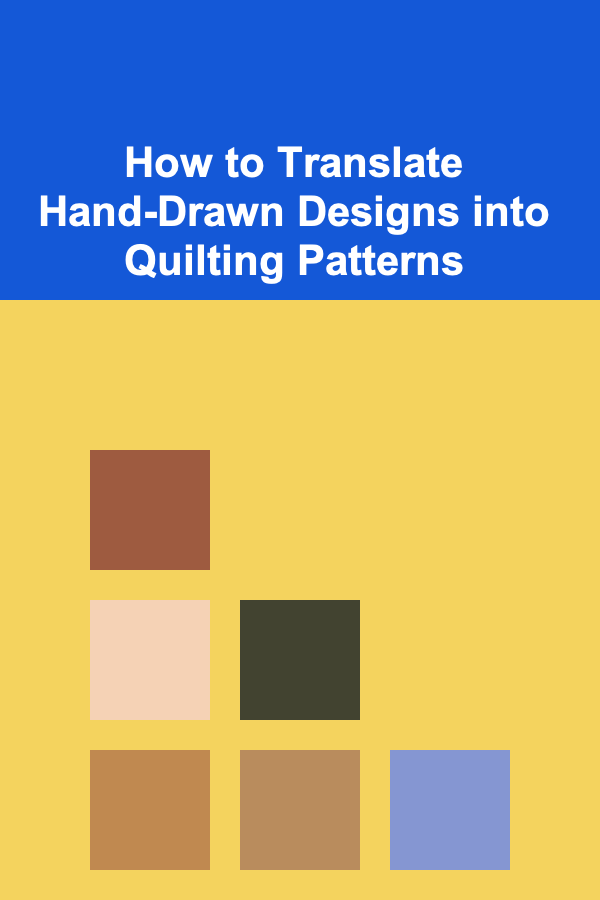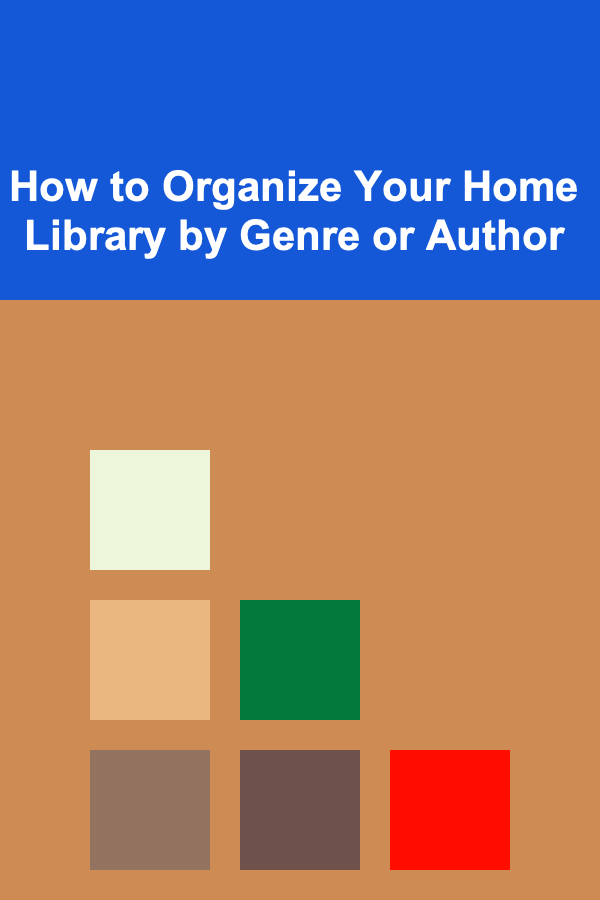
How to Translate Hand-Drawn Designs into Quilting Patterns
ebook include PDF & Audio bundle (Micro Guide)
$12.99$8.99
Limited Time Offer! Order within the next:

Quilting is both an art and a craft, where the careful arrangement of fabrics creates visually stunning and functional pieces. For quilters, creating their own patterns from scratch is an exciting challenge that allows for personal expression and innovation. Many quilters begin with hand-drawn designs, inspired by sketches, patterns in nature, or even abstract ideas, which they then want to translate into quilt patterns. This process involves several steps, from sketching the initial design to creating templates, resizing, and eventually piecing it together into a beautiful quilt. In this article, we will explore how to take your hand-drawn designs and transform them into quilting patterns.
Understanding the Basics of Quilting Patterns
Before diving into the steps of converting hand-drawn designs into quilting patterns, it's important to understand what constitutes a quilting pattern. A quilting pattern typically includes several key elements:
- Block Design: The basic unit of a quilt pattern, often repeated across the quilt. It can be geometric, abstract, or themed.
- Template: Patterns are often traced onto fabric using templates or stencils, which are either hand-drawn or created digitally.
- Finished Dimensions: These specify the exact measurements of each block and the final quilt.
- Cutting Instructions: Detailed instructions on how to cut the fabric pieces to match the design.
When you start with a hand-drawn design, you're essentially converting it into a set of instructions that can be followed to recreate that design with fabric. Whether you're designing a traditional patchwork quilt or a more modern art quilt, the steps remain largely the same.
Step 1: Start with a Clear Vision
A successful quilt pattern starts with a clear design. Your hand-drawn design should be precise and easy to understand. Begin by creating a rough sketch, but keep in mind the scale, symmetry, and overall aesthetic of the quilt.
Key considerations for your design:
- Block Size: If your quilt will feature multiple blocks, determine the size of each block early on. Are they small, like 6-inch blocks, or larger, such as 12-inch blocks?
- Repetition: Many quilts rely on repeating blocks to create a uniform pattern, so think about how your design will repeat across the quilt. Does it have a mirrored effect, or will the blocks be arranged randomly?
- Fabric Choices: Consider the types of fabrics you'll be using. Some designs may require specific fabric types to achieve the desired effect, such as solids for geometric designs or florals for more traditional patterns.
Once the basic concept is clear, refine your hand-drawn design. Make sure that your lines are clean, the proportions are accurate, and that every part of the design is represented. This sketch will serve as your blueprint for the pattern.
Step 2: Break Down the Design into Blocks
Quilting patterns are typically built from blocks that are repeated across the quilt top. If your hand-drawn design is a single, continuous image, you will need to break it down into blocks that can be pieced together.
Steps to break down the design:
- Grid it Out: Draw a grid over your design to help you identify how the pattern can be divided. For example, if you want a pattern with 12-inch blocks, draw a 12-inch grid over your design and see how the elements fit within that size.
- Simplify: Some designs can be complex, and translating them directly to fabric may be challenging. In this case, simplify the design into basic shapes or geometric forms that can be pieced together with ease.
- Define the Edges: Be clear on the edges of each block. A quilting block is usually made up of straight lines, so ensure that the curves or intricate designs are simplified into straight segments or easily measurable shapes.
At this stage, your hand-drawn design is evolving into a more structured format, making it easier to convert into a pattern later on.
Step 3: Create Templates for Each Block
Once you have broken the design down into blocks, the next step is to create templates for each block. Templates are the foundation of quilt patterns, as they are used to trace shapes onto fabric, which are then cut out and pieced together.
How to create templates:
- Using Tracing Paper: Place tracing paper over your design and trace the outlines of each block or shape. Ensure that your lines are smooth and clear. If your design has curves, make sure that they are evenly drawn so that they can be accurately cut.
- Use Graph Paper: For geometric designs, graph paper can be incredibly helpful in scaling and perfecting the design. Each square on the paper can represent a specific measurement, which allows you to keep the pattern consistent.
- Create a Template for Each Piece: For more intricate designs, it may be necessary to create a template for each individual piece that will form the overall block. For example, if you're creating a block that has several different shapes, you will need to create separate templates for each shape.
- Label Your Templates: Label each template with the measurements, as well as any seam allowances that are required when sewing. This is especially important for designs that have intricate pieces.
Step 4: Scale the Design to Your Desired Quilt Size
One of the challenges of translating a hand-drawn design into a quilt pattern is ensuring that the final size of the quilt is to your liking. This is especially important if you want to change the overall dimensions of the quilt, or if you want to make the design fit a specific size block.
Tips for scaling your design:
- Adjust Block Size: If you want the quilt to be larger or smaller, adjust the block size accordingly. For example, if your blocks are too small for the design to be visible, try resizing the blocks to a larger dimension.
- Scale Using Proportions: If you're not sure how to resize your hand-drawn design, use proportional scaling. This method keeps the design in proportion but adjusts the size to match your desired quilt size.
- Recalculate Fabric Requirements: Scaling up the design might also change the amount of fabric you need. As the blocks increase in size, so too will the amount of fabric needed to complete the quilt. Make sure to update your fabric requirements accordingly.
To maintain accuracy and balance throughout the entire quilt, you must make sure that the scale is consistent from block to block.
Step 5: Write Clear Instructions
Now that you have your hand-drawn design, templates, and a plan for the block sizes, it's time to write clear, detailed instructions for creating the quilt. A good quilt pattern should include the following elements:
- Materials List: Include all fabric requirements, including fabric types and quantities, thread, batting, and any additional supplies.
- Cutting Instructions: Provide clear instructions on how to cut each piece of fabric according to the templates.
- Piecing Instructions: Explain how to piece the fabric together, step by step. This might include instructions for sewing individual blocks, joining blocks, and adding borders.
- Quilting and Finishing Instructions: Once the top is pieced, provide instructions for quilting the layers together (if applicable), as well as finishing details such as binding and labeling the quilt.
These instructions should be easy to follow, and any advanced techniques should be clearly explained for quilters of all skill levels.
Step 6: Test the Pattern
Once you have your design and instructions ready, it's time to test the pattern. Make a small sample quilt or block to ensure that everything fits together correctly and that the instructions are clear. This step is essential to identify any issues with sizing, cutting, or piecing before embarking on the full quilt.
What to check during testing:
- Accuracy of Measurements: Make sure that your pieces fit together as planned. If a seam allowance is included, make sure it's consistent.
- Ease of Understanding: Have someone unfamiliar with the pattern try to follow your instructions. This will help identify any unclear steps or potential confusion.
- Fabric Requirements: Double-check that you have enough fabric to complete the quilt, especially if you've scaled the design or made changes.
Testing the pattern will give you the confidence that your design can be successfully translated into a beautiful quilt.
Step 7: Final Adjustments and Refinement
After testing the pattern, refine the instructions and templates as needed. Take feedback into account, and make sure that every detail is clearly outlined. Once you're satisfied with the final product, you're ready to publish your pattern or begin creating your quilt.
Conclusion
Translating hand-drawn designs into quilting patterns is a rewarding creative process that requires attention to detail, patience, and a deep understanding of quilting techniques. By following the steps outlined in this article---starting with a clear vision, breaking down the design, creating templates, scaling the design, writing clear instructions, and testing the pattern---you can successfully turn your hand-drawn ideas into a quilt that reflects your personal style and craftsmanship. Whether you are designing a quilt for personal use or developing patterns for others to follow, the ability to create your own quilting patterns is a skill that will serve you throughout your quilting journey.
Reading More From Our Other Websites
- [Trail Running Tip 101] Seasonal Secrets: How to Trail Run Safely Through the Woods All Year
- [Paragliding Tip 101] From Rookie to Champion: A Step‑by‑Step Guide to Competing in the Paragliding World Championships
- [Stamp Making Tip 101] From Block to Print: Step-by-Step Techniques for Mastering Linoleum Stamp Making
- [Trail Running Tip 101] Best Trail‑Specific Nutrition Bars That Won't Crumble on Rocky Descents
- [Home Budget 101] How to Create a Budget for a New Home Purchase
- [Home Cleaning 101] How to Sanitize Your Kitchen After Cooking
- [Home Lighting 101] How to Make Your Home Feel Warm and Inviting with Lighting
- [Organization Tip 101] How to Set Goals for Each Learning Session
- [Organization Tip 101] How to Refresh Outdated Furniture for Staging
- [Organization Tip 101] How to Choose Furniture that Encourages Relaxation
How to Create a Dashboard for Real-Time Influencer Campaign Tracking
Read More
How to Organize Your Home Library by Genre or Author
Read More
How to Prevent Mold Growth in Your Home
Read More
How to Use Cleaning Supplies Efficiently to Cut Costs
Read More
How to Interpret Your Fitness Traits from Genetics
Read More
How to Track Net Worth for Newly Married Couples
Read MoreOther Products
How to Create a Dashboard for Real-Time Influencer Campaign Tracking
Read More
How to Organize Your Home Library by Genre or Author
Read More
How to Prevent Mold Growth in Your Home
Read More
How to Use Cleaning Supplies Efficiently to Cut Costs
Read More
How to Interpret Your Fitness Traits from Genetics
Read More